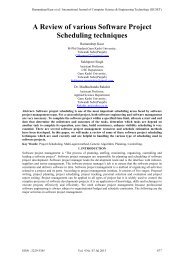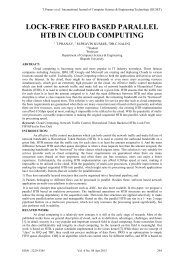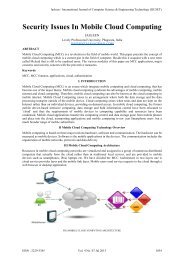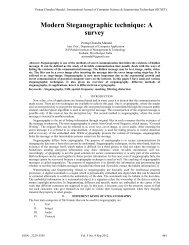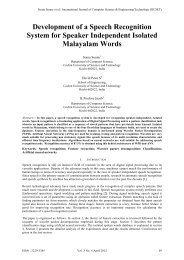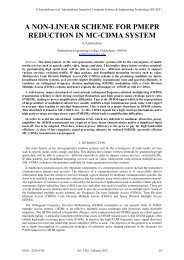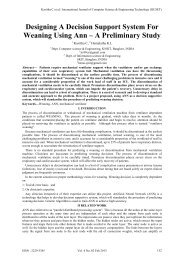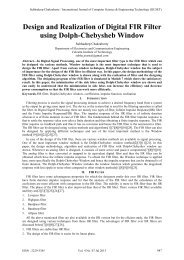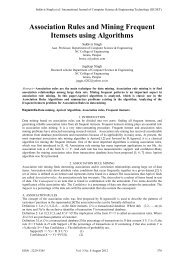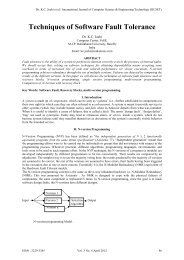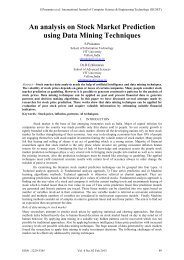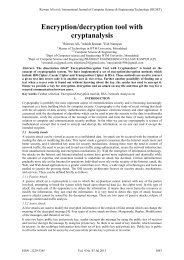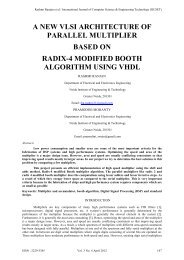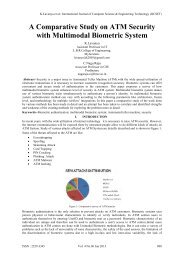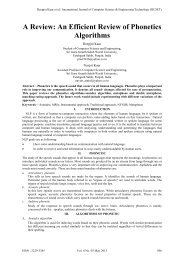Effect of Different Modulation on PAPR and Its Reduction - IJCSET
Effect of Different Modulation on PAPR and Its Reduction - IJCSET
Effect of Different Modulation on PAPR and Its Reduction - IJCSET
Create successful ePaper yourself
Turn your PDF publications into a flip-book with our unique Google optimized e-Paper software.
Ritesh Baranwal et al./ Internati<strong>on</strong>al Journal <str<strong>on</strong>g>of</str<strong>on</strong>g> Computer Science & Engineering Technology (<strong>IJCSET</strong>)<br />
<str<strong>on</strong>g>Effect</str<strong>on</strong>g> <str<strong>on</strong>g>of</str<strong>on</strong>g> <str<strong>on</strong>g>Different</str<strong>on</strong>g> <str<strong>on</strong>g>Modulati<strong>on</strong></str<strong>on</strong>g> <strong>on</strong> <strong>PAPR</strong><br />
<strong>and</strong> <strong>Its</strong> Reducti<strong>on</strong><br />
Ritesh Baranwal * , Anil Kumar # , Pr<str<strong>on</strong>g>of</str<strong>on</strong>g> (Dr.) C.K.Shukla # ,<br />
*PG Student, #Faculty, SHIATS, AAI-DU, ALLAHABAD India 211007<br />
riteshbaranwal01@gmail.com<br />
Abstract—As the technology grow in wireless communicati<strong>on</strong>, the c<strong>on</strong>cept <str<strong>on</strong>g>of</str<strong>on</strong>g> multicarrier<br />
modulati<strong>on</strong> come into picture. Orthog<strong>on</strong>al Frequency Divisi<strong>on</strong> Multiplex(OFDM) prove itself invaluable<br />
for multicarrier modulati<strong>on</strong>.OFDM subcarriers can overlap to make full use <str<strong>on</strong>g>of</str<strong>on</strong>g> the spectrum but at the<br />
peak <str<strong>on</strong>g>of</str<strong>on</strong>g> each subcarriers spectrum, the power in all the other subcarriers is zero. One <str<strong>on</strong>g>of</str<strong>on</strong>g> the major<br />
disadvantages <str<strong>on</strong>g>of</str<strong>on</strong>g> OFDM signal is large <strong>PAPR</strong>, which require power amplifier with large linear (gain)<br />
ranges. But to increase efficiency <str<strong>on</strong>g>of</str<strong>on</strong>g> power amplifier it gain become n<strong>on</strong>linear <strong>and</strong> corresp<strong>on</strong>ding OFDM<br />
signal distort. So, a need for technique which reduces <strong>PAPR</strong>.Selective Mapping with phase rotati<strong>on</strong> is <strong>on</strong>e<br />
<str<strong>on</strong>g>of</str<strong>on</strong>g> the techniques to reduce <strong>PAPR</strong> .In this paper we have to compare the effect <str<strong>on</strong>g>of</str<strong>on</strong>g> different modulati<strong>on</strong><br />
(QPSK, DQPSK, <strong>and</strong> 4-QAM) <strong>on</strong> <strong>PAPR</strong> value <str<strong>on</strong>g>of</str<strong>on</strong>g> OFDM signal <strong>and</strong> its reducti<strong>on</strong> by using selective<br />
mapping phase rotati<strong>on</strong> method.<br />
Keywords — OFDM, <strong>PAPR</strong>, 4- QAM, QPSK, DQPSK, IFFT<br />
INTRODUCTION<br />
OFDM has become an attractive technique <strong>and</strong> gained more popularity recently. Many new communicati<strong>on</strong><br />
systems have selected OFDM because its good properties, e.g. tolerance to inter-symbol interference <strong>and</strong> good<br />
spectral efficiency, capacity to h<strong>and</strong>le very str<strong>on</strong>g echoes <strong>and</strong> less n<strong>on</strong>-linear distorti<strong>on</strong> .So OFDM[1] signal is<br />
adopted by 4G community. Existing 3G systems uses single carrier modulati<strong>on</strong> technique whereas OFDM<br />
which is otherwise known as Multicarrier <str<strong>on</strong>g>Modulati<strong>on</strong></str<strong>on</strong>g> see Figure 1 sends a high speed data stream by splitting it<br />
up to multiple lower speed stream by using serial to parallel c<strong>on</strong>verter <strong>and</strong> transmitting it over a lower<br />
b<strong>and</strong>width. <strong>Its</strong> <str<strong>on</strong>g>of</str<strong>on</strong>g>fer higher data capacity in a given spectrum while allowing a simpler system design. Creating<br />
orthog<strong>on</strong>al subcarriers in the transmitter is easy using an inverse FFT.To ensure this orthog<strong>on</strong>ality is maintained<br />
at the receiver (so that the subcarriers are not misaligned), the system must keep the transmitter <strong>and</strong> receiver<br />
clocks closely synchr<strong>on</strong>ized-within 2 parts per milli<strong>on</strong> in 802.11a systems.In general, an FFT implementati<strong>on</strong> is<br />
much simpler than the RAKE receivers used for CDMA <strong>and</strong> decisi<strong>on</strong>-feedback equalizers for TDMA. However,<br />
a major drawback <str<strong>on</strong>g>of</str<strong>on</strong>g> OFDM is the high peak to- average power ratio (<strong>PAPR</strong>) <str<strong>on</strong>g>of</str<strong>on</strong>g> the transmitted signal, which<br />
requires power amplifier with large linear ranges. Hence, power amplifier requires more back-<str<strong>on</strong>g>of</str<strong>on</strong>g>f which in turn<br />
reduces the power efficiency. Some other problems include phase distorti<strong>on</strong>, time-varying channel <strong>and</strong> time<br />
synchr<strong>on</strong>izati<strong>on</strong>. There are various technique is used to reduce the <strong>PAPR</strong> <str<strong>on</strong>g>of</str<strong>on</strong>g> OFDM signal like clipping,SLM<br />
technique, Partial transmit sequence(PTS)[13] <str<strong>on</strong>g>of</str<strong>on</strong>g> which Selective mapping with phase rotati<strong>on</strong> is used in this<br />
paper.<br />
OFDM is used as the modulati<strong>on</strong> method for Digital Audio Broadcasting (DAB) <strong>and</strong> terrestrial Digital video<br />
Broadcasting (DVT-T) in Europe, <strong>and</strong> in asymmetric digital subscriber line (ADSL).Wireless local area network<br />
use OFDM as their physical layer transmissi<strong>on</strong> technique.OFDM is also a str<strong>on</strong>g c<strong>and</strong>idate for IEEE wireless<br />
pers<strong>on</strong>al area network st<strong>and</strong>ard <strong>and</strong> for fourth generati<strong>on</strong> (4G) cellular systems.<br />
II. ORTHOGONALITY OF SIGNAL<br />
Orthog<strong>on</strong>al signals [2] can be viewed in the same perspective as we view vectors which are<br />
perpendicular/orthog<strong>on</strong>al to each other. The inner product <str<strong>on</strong>g>of</str<strong>on</strong>g> two mutually orthog<strong>on</strong>al vectors is equal to zero.<br />
Similarly the inner product <str<strong>on</strong>g>of</str<strong>on</strong>g> two orthog<strong>on</strong>al signals is also equal to zero.<br />
Let 1(t) = <strong>and</strong> 2(t) = be two complex exp<strong>on</strong>ential signals whose inner product, over the time<br />
durati<strong>on</strong> <str<strong>on</strong>g>of</str<strong>on</strong>g> T, is given by:<br />
M = (t) ----------------(1)<br />
When this integral is evaluated, it is found that if <strong>and</strong> are integer multiples <str<strong>on</strong>g>of</str<strong>on</strong>g> 1/T then M equals zero.<br />
This implies that for two harm<strong>on</strong>ics <str<strong>on</strong>g>of</str<strong>on</strong>g> an exp<strong>on</strong>ential functi<strong>on</strong> having a fundamental frequency <str<strong>on</strong>g>of</str<strong>on</strong>g> 1/T, the inner<br />
ISSN : 2229-3345 Vol. 3 No. 8 August 2012 309
Ritesh Baranwal et al./ Internati<strong>on</strong>al Journal <str<strong>on</strong>g>of</str<strong>on</strong>g> Computer Science & Engineering Technology (<strong>IJCSET</strong>)<br />
product becomes zero. But if = then M equals T which is nothing but the energy <str<strong>on</strong>g>of</str<strong>on</strong>g> the complex<br />
exp<strong>on</strong>ential signal in the time durati<strong>on</strong> <str<strong>on</strong>g>of</str<strong>on</strong>g> T.<br />
This paper is organized as follows secti<strong>on</strong> II gives orthog<strong>on</strong>ality <str<strong>on</strong>g>of</str<strong>on</strong>g> Signals. An overview <str<strong>on</strong>g>of</str<strong>on</strong>g> system model is<br />
given in Secti<strong>on</strong> III.Brief descripti<strong>on</strong> <str<strong>on</strong>g>of</str<strong>on</strong>g> Selective mapping with Phase rotati<strong>on</strong> technique is given in secti<strong>on</strong><br />
IV.Algorithm for reduced <strong>PAPR</strong> is given in secti<strong>on</strong> V.Simulati<strong>on</strong> parameter in secti<strong>on</strong> VI <strong>and</strong> finally Simulati<strong>on</strong><br />
result with c<strong>on</strong>clusi<strong>on</strong> is given in secti<strong>on</strong> VII,VIII.<br />
N Serial Data Symbols<br />
Subcarriers<br />
Subcarriers<br />
Serial to Parallel Transmissi<strong>on</strong><br />
1<br />
M-1<br />
M Parallel Data Symbols<br />
Figure1: Multicarrier Transmissi<strong>on</strong> Technique<br />
III.SYSTEM MODEL<br />
Assume that the data (bit) stream is generated by using R<strong>and</strong>om integer generator block <str<strong>on</strong>g>of</str<strong>on</strong>g><br />
MATLAB/SIMULINK. These data value are modulated by using QPSK, DQPSK, <strong>and</strong> 4-QAM modulati<strong>on</strong>. For<br />
simplicity, assume a square c<strong>on</strong>stellati<strong>on</strong> such as square QAM .Let us denote the data block <str<strong>on</strong>g>of</str<strong>on</strong>g> length M as a<br />
vector X =<br />
where M is equal to the number <str<strong>on</strong>g>of</str<strong>on</strong>g> subcarriers. Then it is given to serial to<br />
parallel c<strong>on</strong>verter which generates a four copy <str<strong>on</strong>g>of</str<strong>on</strong>g> data value. By looking carefully, these data value are in<br />
frequency domain. These frequency domain data value are given phase rotati<strong>on</strong> from 1,2,3……….V.After that it<br />
is given to IFFT <str<strong>on</strong>g>of</str<strong>on</strong>g> size 64 which c<strong>on</strong>vert frequency domain signal into time domain signal.IFFT also maintain<br />
the orthog<strong>on</strong>ality <str<strong>on</strong>g>of</str<strong>on</strong>g> these subcarriers. The number <str<strong>on</strong>g>of</str<strong>on</strong>g> subcarriers is given by dividing no. <str<strong>on</strong>g>of</str<strong>on</strong>g> data value with<br />
IFFT.The complex envelope <str<strong>on</strong>g>of</str<strong>on</strong>g> the transmitted OFDM signal is given by<br />
y (t) = , 0 t MT ------------- (2)<br />
Now, the peak to average power ratio is calculated by using the formula.<br />
<strong>PAPR</strong> = = ---------------- (3)<br />
ISSN : 2229-3345 Vol. 3 No. 8 August 2012 310
Ritesh Baranwal et al./ Internati<strong>on</strong>al Journal <str<strong>on</strong>g>of</str<strong>on</strong>g> Computer Science & Engineering Technology (<strong>IJCSET</strong>)<br />
IFFT<br />
SERIAL<br />
SELECT<br />
DATA<br />
SOURCE<br />
TO<br />
PARAL<br />
LEL<br />
CONV<br />
ERSIO<br />
N<br />
1<br />
2<br />
IFFT<br />
IFFT<br />
ONE WITH<br />
LOWEST<br />
<strong>PAPR</strong><br />
3<br />
1, 2, 3:- CARRIERSWISE PHASE (U) SEQUENCES<br />
Figure2: Block Diagram <str<strong>on</strong>g>of</str<strong>on</strong>g> OFDM Transmitter with the SLM Technique1<br />
IV.SELECTIVE MAPPING WITH PHASE ROTATION TECHNIQUE<br />
In SLM technique firstly [11], the input informati<strong>on</strong> is divided into OFDM data block Y, which c<strong>on</strong>sists <str<strong>on</strong>g>of</str<strong>on</strong>g> M<br />
symbols, by the serial-to parallel c<strong>on</strong>versi<strong>on</strong> <strong>and</strong> then data block Y is multiplied carrier wise with each <strong>on</strong>e <str<strong>on</strong>g>of</str<strong>on</strong>g><br />
the U different phase sequences<br />
, resulting in a set <str<strong>on</strong>g>of</str<strong>on</strong>g> U different OFDM data blocks<br />
= [ , , ]^T ------------------------- (4 )<br />
= . ‐‐‐‐‐‐‐‐‐‐‐‐‐‐‐‐‐‐‐‐‐‐‐‐‐‐‐‐‐‐ (5)<br />
m = 0, 1, · ·, M − 1, u = 1, 2, · · , U. Then all phase rotati<strong>on</strong> (U) alternative data blocks are transformed into time<br />
domain to get transmit OFDM symbol = IFFT { }.The informati<strong>on</strong> <strong>on</strong> the selected phase sequence must<br />
be transmitted to the receiver. All U phase rotated OFDM data blocks represented the same informati<strong>on</strong> as the<br />
unmodified OFDM data block Provided that the phase sequence is known [13]. After applying the selective<br />
mapping phase sequence, the complex envelope <str<strong>on</strong>g>of</str<strong>on</strong>g> the transmitted OFDM signal becomes<br />
y (t) = , 0 t MT -------------------------------(-6)-<br />
Here, MT is the durati<strong>on</strong> <str<strong>on</strong>g>of</str<strong>on</strong>g> an OFDM data block. Output data <str<strong>on</strong>g>of</str<strong>on</strong>g> the lowest <strong>PAPR</strong> is selected to transmit. Figure<br />
2 shows the block diagram <str<strong>on</strong>g>of</str<strong>on</strong>g> OFDM transmitter with Selective mapping phase rotati<strong>on</strong> technique. This<br />
technique effectively reduces Peak to Average Power Ratio without any signal distorti<strong>on</strong>. But the system<br />
become complex. This complexity can less by reducing the number <str<strong>on</strong>g>of</str<strong>on</strong>g> IFFT block [3, 4, <strong>and</strong> 5].Here IFFT block<br />
also maintain the orthog<strong>on</strong>ality <str<strong>on</strong>g>of</str<strong>on</strong>g> subcarriers.<br />
V. ALGORITHM FOR REDUCED <strong>PAPR</strong><br />
1. Generate data value <str<strong>on</strong>g>of</str<strong>on</strong>g> size Y = Y1, Y2, Y3…….YM.<br />
2. These data value are modulated using QPSK, DQPSK, <strong>and</strong> 4-QAM.<br />
3. These data value are given phase rotati<strong>on</strong> (U) from 1 to 4 degree. We get = .<br />
4. After giving phase rotati<strong>on</strong> we get signal = , , , ----------- .<br />
5. These frequency domain signal given to IFFT which c<strong>on</strong>vert it into time domain .The signal<br />
from each IFFT is orthog<strong>on</strong>al signals (subcarriers).<br />
ISSN : 2229-3345 Vol. 3 No. 8 August 2012 311
Ritesh Baranwal et al./ Internati<strong>on</strong>al Journal <str<strong>on</strong>g>of</str<strong>on</strong>g> Computer Science & Engineering Technology (<strong>IJCSET</strong>)<br />
6. Now, calculate the <strong>PAPR</strong> by using the equati<strong>on</strong> no.3 <strong>and</strong> select the least <strong>PAPR</strong> OFDM signal.<br />
VI. .SIMULATION PARAMETER<br />
No. <str<strong>on</strong>g>of</str<strong>on</strong>g> Sub Carriers : 900<br />
IFFT Size : 64<br />
Phase rotati<strong>on</strong> (U) : 4<br />
<str<strong>on</strong>g>Modulati<strong>on</strong></str<strong>on</strong>g><br />
: QPSK, DQPSK, 4-QAM<br />
No. <str<strong>on</strong>g>of</str<strong>on</strong>g> Data points : 57600<br />
C<strong>on</strong>stellati<strong>on</strong> mapping : 32<br />
VII.SIMULATION RESULT<br />
All the simulati<strong>on</strong> will be performed in MATLAB 7.8.When we calculate the <strong>PAPR</strong> without phase<br />
rotati<strong>on</strong> selective mapping technique for DQPSK <str<strong>on</strong>g>Modulati<strong>on</strong></str<strong>on</strong>g> the <strong>PAPR</strong> is found to be 9.796dB.But when<br />
selective mapping with phase rotati<strong>on</strong> for same modulati<strong>on</strong> is used the <strong>PAPR</strong> value found to be 8.111dB.So, the<br />
value reduced by factor 1.685dB.Figure 3,4 shows the <strong>PAPR</strong> <str<strong>on</strong>g>of</str<strong>on</strong>g> BASIC OFDM system using QPSK,DQPSK<br />
modulati<strong>on</strong>.<br />
Figure3: <strong>PAPR</strong> <str<strong>on</strong>g>of</str<strong>on</strong>g> BASIC QPSK OFDM System<br />
Figure4: <strong>PAPR</strong> <str<strong>on</strong>g>of</str<strong>on</strong>g> BASIC DQPSK OFDM system<br />
Figure5: <strong>PAPR</strong> <str<strong>on</strong>g>of</str<strong>on</strong>g> BASIC QPSK OFDM system with SLM technique<br />
Figure6: <strong>PAPR</strong> <str<strong>on</strong>g>of</str<strong>on</strong>g> BASIC DQPSK OFDM system<br />
with SLM Technique<br />
ISSN : 2229-3345 Vol. 3 No. 8 August 2012 312
Ritesh Baranwal et al./ Internati<strong>on</strong>al Journal <str<strong>on</strong>g>of</str<strong>on</strong>g> Computer Science & Engineering Technology (<strong>IJCSET</strong>)<br />
Figure7: <strong>PAPR</strong> <str<strong>on</strong>g>of</str<strong>on</strong>g> BASIC 4-QAM OFDM system with SLM Technique<br />
Figure 8: <strong>PAPR</strong> <str<strong>on</strong>g>of</str<strong>on</strong>g> BASIC 4-QAM<br />
OFDM system without SLM technique<br />
Also when we calculate the <strong>PAPR</strong> <str<strong>on</strong>g>of</str<strong>on</strong>g> BASIC OFDM system using QPSK, 4-QAM modulati<strong>on</strong> the value come<br />
out to be 10.28dB <strong>and</strong> 10.69dB as shown in figure 3, 8 But when we apply the phase rotati<strong>on</strong> technique to<br />
OFDM signal the reduced <strong>PAPR</strong> value come out to be 7.819dB, 7.451dB as shown in figure 5, 7.so the value<br />
reduced by 2.461dB, 3.239dB. From below Table 1 shows that more <strong>PAPR</strong> value is reduced with 4-QAM<br />
modulati<strong>on</strong> its come out to be 3.239dB.<br />
Table1: Comparis<strong>on</strong> <str<strong>on</strong>g>of</str<strong>on</strong>g> <str<strong>on</strong>g>Different</str<strong>on</strong>g> <str<strong>on</strong>g>Modulati<strong>on</strong></str<strong>on</strong>g> with <strong>PAPR</strong> <str<strong>on</strong>g>of</str<strong>on</strong>g> OFDM signal<br />
Comparis<strong>on</strong> <str<strong>on</strong>g>of</str<strong>on</strong>g> Peak to Average Power Ratio(dB) With &<br />
Without Phase Rotati<strong>on</strong> QPSK DQPSK 4-QAM<br />
Without Phase Rotati<strong>on</strong> 10.28 9.796 10.69<br />
With Phase Rotati<strong>on</strong> 7.819 8.111 7.451<br />
Difference in Peak To Average Power Ratio (dB) Without<br />
With Phase Rotati<strong>on</strong><br />
&<br />
2.461 1.685 3.239<br />
VIII. CONCLUSION<br />
Reducing <strong>PAPR</strong> <str<strong>on</strong>g>of</str<strong>on</strong>g> OFDM signal is important for increasing the performance Of Communicati<strong>on</strong> equipment. So<br />
in this paper <str<strong>on</strong>g>of</str<strong>on</strong>g> all the different modulati<strong>on</strong> (QPSK, DQPSK, <strong>and</strong> 4-QAM) <strong>on</strong> OFDM signal we can able to find<br />
the least <strong>PAPR</strong> <str<strong>on</strong>g>of</str<strong>on</strong>g> OFDM signal. Also optimize the <strong>PAPR</strong> value by phase rotati<strong>on</strong> technique, <strong>on</strong> doing different<br />
modulati<strong>on</strong> <strong>on</strong> OFDM signal. The proposed Selective Mapping with phase rotati<strong>on</strong> technique is simple <strong>and</strong><br />
achieves significant reducti<strong>on</strong> in <strong>PAPR</strong>. Results <str<strong>on</strong>g>of</str<strong>on</strong>g> simulati<strong>on</strong> <str<strong>on</strong>g>of</str<strong>on</strong>g> SLM technique show that the least <strong>PAPR</strong><br />
reducti<strong>on</strong> <str<strong>on</strong>g>of</str<strong>on</strong>g> OFDM system for 4-QAM modulati<strong>on</strong> <str<strong>on</strong>g>of</str<strong>on</strong>g> all three modulati<strong>on</strong>s sees table1. Which further results in<br />
high performance <str<strong>on</strong>g>of</str<strong>on</strong>g> wireless communicati<strong>on</strong>. With the rising dem<strong>and</strong> for efficient use <str<strong>on</strong>g>of</str<strong>on</strong>g> frequency spectrum,<br />
OFDM proves invaluable to 4G communicati<strong>on</strong> systems.<br />
ISSN : 2229-3345 Vol. 3 No. 8 August 2012 313
Ritesh Baranwal et al./ Internati<strong>on</strong>al Journal <str<strong>on</strong>g>of</str<strong>on</strong>g> Computer Science & Engineering Technology (<strong>IJCSET</strong>)<br />
REFRENCES<br />
[1] L.J.Cimini, Jr, “Analysis <strong>and</strong> Simulati<strong>on</strong> <str<strong>on</strong>g>of</str<strong>on</strong>g> a Digital Mobile Channel using OFDM”, IEEE Trans. On Communicati<strong>on</strong>s, vol.Com-33,<br />
no.7, pp.665-675, July 1985.<br />
[2] Dr. Abhijit Mitra, a Lecture Notes <strong>on</strong> Mobile Communicati<strong>on</strong>, a Curriculum Development Cell Project under QIP, Department <str<strong>on</strong>g>of</str<strong>on</strong>g><br />
Electr<strong>on</strong>ics <strong>and</strong> Communicati<strong>on</strong> Engineering, Indian Institute <str<strong>on</strong>g>of</str<strong>on</strong>g> Technology, Guwahati India, <strong>and</strong> November 2009.<br />
[3] Seung Hee Han <strong>and</strong> Jae H<strong>on</strong>g Lee, .Modified selected Mapping Technique for <strong>PAPR</strong> reducti<strong>on</strong> <str<strong>on</strong>g>of</str<strong>on</strong>g> coded OFDM signal., IEEE<br />
Transacti<strong>on</strong> <strong>on</strong> broadcasting, Vol.50, No.3, pp.335-341, Sept. 2004.<br />
[4] Yang Jie, Chen Lei, Liu Quan <strong>and</strong> Chan De, .A Modified selected mapping technique to reduce the Peak to Average Power Ratio <str<strong>on</strong>g>of</str<strong>on</strong>g><br />
OFDM signal. IEEE transacti<strong>on</strong> <strong>on</strong> c<strong>on</strong>sumer Electr<strong>on</strong>ics, Vol53, No.3, pp. 846-851, August 2007.<br />
[5] Stefan H.Muller <strong>and</strong> Johannes B. Huber, .A Comparis<strong>on</strong> <str<strong>on</strong>g>of</str<strong>on</strong>g> Peak Power Reducti<strong>on</strong> Schemes for OFDM, In Proc. <str<strong>on</strong>g>of</str<strong>on</strong>g> The IEEE Global<br />
Telecommunicati<strong>on</strong>s c<strong>on</strong>ference GLOBECOM. 97, Ph<strong>on</strong>ix, Ariz<strong>on</strong>a, USA, pp.1-5, Nov. 1997.<br />
[6] R.W Chang, “Orthog<strong>on</strong>al Frequency Divisi<strong>on</strong> Multiplexing,” U.S Patent 3388455, Jan 6, 1970, Filed Nov.4.1966.<br />
[7] B.R. Satzberg, “Performance <str<strong>on</strong>g>of</str<strong>on</strong>g> an Efficient Parallel Data Transmissi<strong>on</strong> System,”IEEE Trans. Commun. Technol., Vol.COM-15, no.6,<br />
pp. 805-811, Dec 1967.<br />
[8] X. Li <strong>and</strong> L. J. Cimini Jr., ”<str<strong>on</strong>g>Effect</str<strong>on</strong>g>s <str<strong>on</strong>g>of</str<strong>on</strong>g> clipping <strong>and</strong> filtering <strong>on</strong> the performance <str<strong>on</strong>g>of</str<strong>on</strong>g> OFDM,” IEEE Communicati<strong>on</strong> Letters, pp. 131-<br />
133, May 1998.<br />
[9] Xiao Huang, Jianhua Lu, Justin Chuang, <strong>and</strong> Junli Zheng, ”Comp<strong>and</strong>ing transform for the reducti<strong>on</strong> <str<strong>on</strong>g>of</str<strong>on</strong>g> peak to average power ratio <str<strong>on</strong>g>of</str<strong>on</strong>g><br />
OFDM signal,” IEEE Trans. On Commun. vol. 48, pp. 835-839, May 2001.<br />
[10] A. E. J<strong>on</strong>es, T. A. Wilkins<strong>on</strong> <strong>and</strong> S. K. Bart<strong>on</strong>,”Block coding scheme for reducti<strong>on</strong> <str<strong>on</strong>g>of</str<strong>on</strong>g> peak to mean envelope power ratio <str<strong>on</strong>g>of</str<strong>on</strong>g><br />
multicarrier transmissi<strong>on</strong> schemes,” Electr<strong>on</strong>ic Letters, pp. 2098-2099, Dec. 1994.<br />
[11] R. W. Bauml, R. F. H. Fisher, <strong>and</strong> J. B. Huber, “Reducing the peak-to average power ratio <str<strong>on</strong>g>of</str<strong>on</strong>g> multicarrier modulati<strong>on</strong> by selected<br />
mapping,” Electr<strong>on</strong>. Letter. vol. 32, no. 22, pp. 2056–2057, Oct. 1996.<br />
[12] Yang Jie, Chen Lei, Liu Quan <strong>and</strong> Chan De, .A Modified selected mapping technique to reduce the Peak to Average Power Ratio <str<strong>on</strong>g>of</str<strong>on</strong>g><br />
OFDM signal. IEEE Transacti<strong>on</strong> <strong>on</strong> c<strong>on</strong>sumer Electr<strong>on</strong>ics, Vol53, No.3, pp. 846-851, August 2007.<br />
[13] Xin_Chun Wu, Jin_Xiang Wang, Zhi_Gang Mao, .A Novel PTS Architecture for <strong>PAPR</strong> Reducti<strong>on</strong> <str<strong>on</strong>g>of</str<strong>on</strong>g> OFDM signals., ICCS IEEE<br />
2008, pp. 1055-1060.<br />
[14] Yang Chan Cho, Seung Hee Han,<strong>and</strong> Jae H<strong>on</strong>g Lee ,Selected Mapping technique with novel phase sequences for reducti<strong>on</strong> <str<strong>on</strong>g>of</str<strong>on</strong>g> an<br />
OFDM signal.,pp.4781-4785,2004.<br />
[15] Marco Breiling ,Stefan H. Muller-Weinfurtner <strong>and</strong> Johanes B.Huber,”SLM Peak-Power Reducti<strong>on</strong> Without Explicit Side<br />
Informati<strong>on</strong>”, IEEE Communicati<strong>on</strong>s Letters, VOL.5, No.6, pp.239-241, JUNE 2001.<br />
[16] V. Vijayaranjan, DR.(MRs) Sukanesh, An overview <str<strong>on</strong>g>of</str<strong>on</strong>g> technique for reducing <strong>PAPR</strong> <strong>and</strong> its selecti<strong>on</strong> criteria for OFDM Radio<br />
System.,Journal <str<strong>on</strong>g>of</str<strong>on</strong>g> Theorithical <strong>and</strong> Applied IT ,pp.25-36,2005-2009.<br />
[17] Yang Chan Cho, Seung Hee Han, <strong>and</strong> Jae H<strong>on</strong>g Lee,” Selected Mapping Technique with Novel Phase Sequences for <strong>PAPR</strong><br />
Reducti<strong>on</strong> <str<strong>on</strong>g>of</str<strong>on</strong>g> an OFDM Signal,” Vehicular Technology c<strong>on</strong>ference, 2004.VTC 2004-Fall, 2004 IEEE vol. 7, pp. 4781-4787, Sep 2004.<br />
[18] V. B. Malode, Dr. B. P. Patil,” <strong>PAPR</strong> Reducti<strong>on</strong> Using Modified Selective Mapping Technique”, Int. J. <str<strong>on</strong>g>of</str<strong>on</strong>g> Advanced Networking <strong>and</strong><br />
Applicati<strong>on</strong>s, Volume: 02, Issue: 02, Pages: 626-630, August 2010.<br />
ISSN : 2229-3345 Vol. 3 No. 8 August 2012 314



